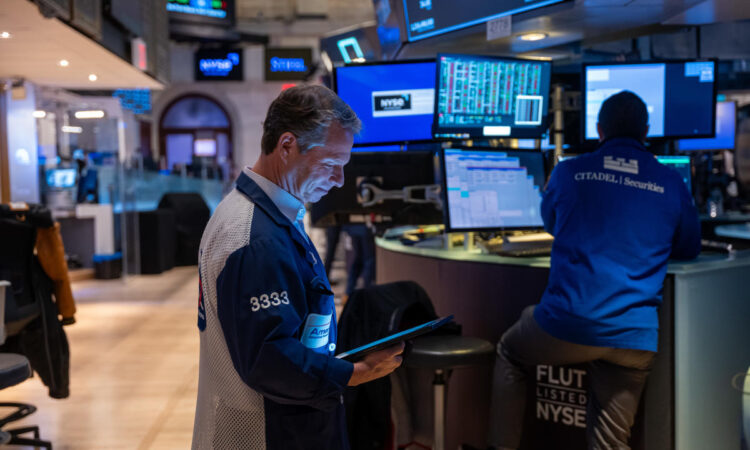
(Bloomberg) — The stock market ended the week on a positive note after a blowout jobs report signaled the US economy will continue to power Corporate America — even if that means the potential for still elevated interest rates.
Most Read from Bloomberg
All major groups in the S&P 500 gained, with the gauge rising more than 1%. Wall Street decided to look at the glass half full on Friday based on the premise that if the economy is still so strong, there would be no real urgency for the Federal Reserve to start easing policy.
That triggered another hawkish reprice in the bond market. Treasury yields climbed, with traders dialing back their projections for Fed cuts in 2024 to about 65 basis points — or less than what the central bank forecast last month.
Never miss an episode. Follow the Big Take podcast on iHeart, Apple Podcasts, Spotify or wherever you listen. Read the transcript.
US payrolls swelled by 303,000 in March, topping all estimates. The unemployment rate edged lower to 3.8%, wages grew at a solid clip, and workforce participation rose, underscoring the strength of a labor market that’s driving the economy.
“Bang! Employment up, rate cuts need to come out,” said George Mateyo at Key Wealth. “The Fed will likely need to reconsider its current stance of three rate cuts this year. But, the reason for this likely change in posture is bullish – the economy is doing well.”
The S&P 500 topped 5,200, though Friday’s advance didn’t prevent the gauge from notching its worst week since January. Meta Platforms Inc. led gains in megacaps. Tesla Inc. closed away from session lows as Elon Musk denied a report saying the carmaker had called off plans for a less-expensive vehicle.
Treasury 10-year yields rose nine basis points to 4.40%. Brent oil held above $90 amid geopolitical tensions.
“It’s hard to find anything wrong with the March Jobs report,” said Steve Wyett at BOK Financial. “The only people who might be disappointed in today’s report are those looking for relief from Fed rate cuts. We still expect the next move from the Fed to be to lower rates, but there is little sense of urgency at the moment.”
To the extent that consumer spending and corporate profits are more important to investors than how soon — and how many times — the Fed will cut rates, then stocks can move higher, according to Chris Zaccarelli at Independent Advisor Alliance.
“The number of rate cuts and whether they begin in June or July isn’t as important as whether the Fed is in rate-cutting mode or not,” he note. “To put it another way, 4 or 3 or 2 rate cuts in 2024 are all equally good for the stock market. But if we went to zero rate cuts or a rate hike, then all bets are off and that would be categorically bad.”
Friday’s jobs report indicates that the economy remains resilient even in the face of fading expectations of Fed cuts, says Glen Smith at GDS Wealth Management.
“The fact that the labor market is so strong shows that companies and the economy are adapting to high interest rates,” he noted.
Mohamed El-Erian still expects Fed officials to cut interest rates twice this year, even as a solid jobs report pushes traders to rethink the timing.
“If this Fed is continuously overly data dependent, then maybe we don’t get cuts,” El-Erian, the president of Queens’ College, Cambridge and a Bloomberg Opinion columnist, said on Bloomberg Television. “But I am hoping that they will see through the backward-looking data and look forward.”
Traders ceased fully pricing in a Fed rate cut before September after the March employment report. Swap contracts that predict the central bank’s rate decisions trimmed the probability of rate cut in June to about 52%. For July, the probability dropped below 100%.
Fed Bank of Dallas President Lorie Logan said it’s too soon to consider cutting rates, citing recent high inflation readings and signs that borrowing costs may not be holding back the economy as much as previously thought. Governor Michelle Bowman also expressed her concern about potential upside risks to inflation, reiterating it’s “still not yet” time to lower rates.
Jerome Powell has said strong hiring on its own isn’t enough to delay policy easing, but Friday’s jobs report — especially when paired with a pickup in key inflation numbers at the start of 2024 — raise the possibility of later or fewer cuts this year.
“There is no weakness in the job market which would impel the Fed to quickly cut, but no tightness which would prohibit a cut either,” said Preston Caldwell at Morningstar. “Fed decisions in upcoming meetings will hinge mainly on the inflation data.”
Officials will see fresh figures on consumer and producer prices next week, followed by the March reading of their preferred inflation gauge — the personal consumption expenditures price index — before their April 30-May 1 meeting.
“Our base case remains that the Fed will cut rates in June with a total of three cuts by the end of 2024, but some softening of both the labor market data and the inflation data is likely required for that to happen,” said Brian Rose at UBS Global Wealth Management. “Next week, markets are likely to focus on the CPI data for March — which we expect to show a smaller monthly increase than in the prior two months.”
The evolution of consumer price inflation remains the key determinant of easing in the short term — which raises the stakes for next week’s CPI report, according to Oscar Munoz and Gennadiy Goldberg at TD Securities.
“We remain of the view that the June meeting remains live in terms of when the Fed could begin to cut rates.”
To David Russell at TradeStation, while a June rate cut might be at risk, next week’s CPI number will probably be a “bigger litmus test” for the Fed.
“The bears haven’t won yet,” he said.
Wall Street’s Reaction to Jobs Data:
Oops, we did it again. Today’s employment report showed a labor market that was again ahead of expectations.
On the whole, this report doesn’t by itself alter the Fed’s rate cut plan, but along with other information could be used to argue for only 2 cuts in 2024, instead of the currently expected 3 cuts.
While we still think the Fed will cut, this jobs report should indicate that there is no rush and no need for the Fed to save the labor market, especially if it will just reignite inflation down the road.
I still forecast a rate cut in June, but I’m waiting for that Wednesday CPI report shows. From a basic policy perspective there’s very little need to start cutting rates because the economy is still so strong.
Another blowout payroll report suggests the economy is running strong and far from recession. On balance, this would push out any rate cuts by the Fed, but easing wage growth means we’re not in the middle of a labor-market induced inflation surge.
This is a strong labor economy that shows little sign of stalling in the near term. What’s it mean for interest rates? There’s even less reason for the Fed to feel any sense of urgency in announcing that much-anticipated first rate cut.
There’s a lot to like in the March employment report. Federal Reserve officials can remain confident that they’re satisfying the maximum employment component of their dual mandate. The big question is when and if they can begin to cut interest rates in the battle against inflation.
We still believe that the Fed will begin insurance cuts later this year to make the soft landing a reality. Especially given that some of the recent data away from payrolls has shown a decline in macro momentum.
Stop me if you’ve seen this headline before, but we have yet again another massive jobs beat.
The reason for the beat at this point is irrelevant, the main take away is that once again the Fed is put in an impossible position. The rate-cut lifeboats everyone was expecting have drifted further out to see and we are staying at the vast expanse of higher for longer.
Aside from key inflation data next week, traders will also focus on the start of the earnings season — with JPMorgan Chase & Co., Wells Fargo & Co. and Citigroup Inc. due to report their results on Friday.
“Earnings season is likely to show a bifurcated market where many companies are thriving, but an increasing minority are struggling,” said Yung-Yu Ma at BMO Wealth Management. “In part, that mirrors the overall economy where lower socioeconomic groups face greater strains, but the bifurcation is also the result of higher interest rates and other shifts taking place in the economy.”
Investors had poured $7.1 billion into US stocks in the week through Wednesday, according to Bank of America Corp. strategists who cited EPFR Global data. US equity flows are annualizing to $310 billion, the second highest ever. Tech stocks are annualizing $73 billion, an all-time high.
“The relatively modest pullback in equities from record levels despite a substantial rise in interest rates and the shift in Fed expectations is a reflection of the resilience of the market,” said Mark Hackett at Nationwide. “The next challenge is earnings season, with the reaction to news likely to pave the path forward for equities.”
Corporate Highlights:
-
United Airlines Holdings Inc. is calling off an investor meeting scheduled for early next month because it would “send the wrong message” to celebrate its performance in the wake of a series of headline-grabbing safety incidents.
-
Johnson & Johnson agreed to acquire Shockwave Medical Inc. for about $13.1 billion to bolster its expansion into making medical devices to treat heart disease.
-
Meta Platforms Inc. asked a judge to dismiss the US Federal Trade Commission’s antitrust lawsuit seeking to break up the company, saying the agency can’t prove consumers would be better off without its acquisitions of Instagram and WhatsApp.
-
Chesapeake Energy Corp.’s $7.4 billion takeover of Southwestern Energy Co. has been delayed until the second half of the year after antitrust regulators demanded more details from the natural gas explorers.
Some of the main moves in markets:
Stocks
-
The S&P 500 rose 1.1% as of 4 p.m. New York time
-
The Nasdaq 100 rose 1.3%
-
The Dow Jones Industrial Average rose 0.8%
-
The MSCI World index rose 0.4%
Currencies
-
The Bloomberg Dollar Spot Index was little changed
-
The euro was little changed at $1.0835
-
The British pound was little changed at $1.2634
-
The Japanese yen fell 0.2% to 151.64 per dollar
Cryptocurrencies
-
Bitcoin fell 0.7% to $67,447.63
-
Ether fell 0.1% to $3,321.25
Bonds
-
The yield on 10-year Treasuries advanced nine basis points to 4.40%
-
Germany’s 10-year yield advanced four basis points to 2.40%
-
Britain’s 10-year yield advanced five basis points to 4.07%
Commodities
-
West Texas Intermediate crude rose 0.1% to $86.71 a barrel
-
Spot gold rose 1.4% to $2,323.68 an ounce
This story was produced with the assistance of Bloomberg Automation.
–With assistance from Natalia Kniazhevich and Liz Capo McCormick.
Most Read from Bloomberg Businessweek
©2024 Bloomberg L.P.

